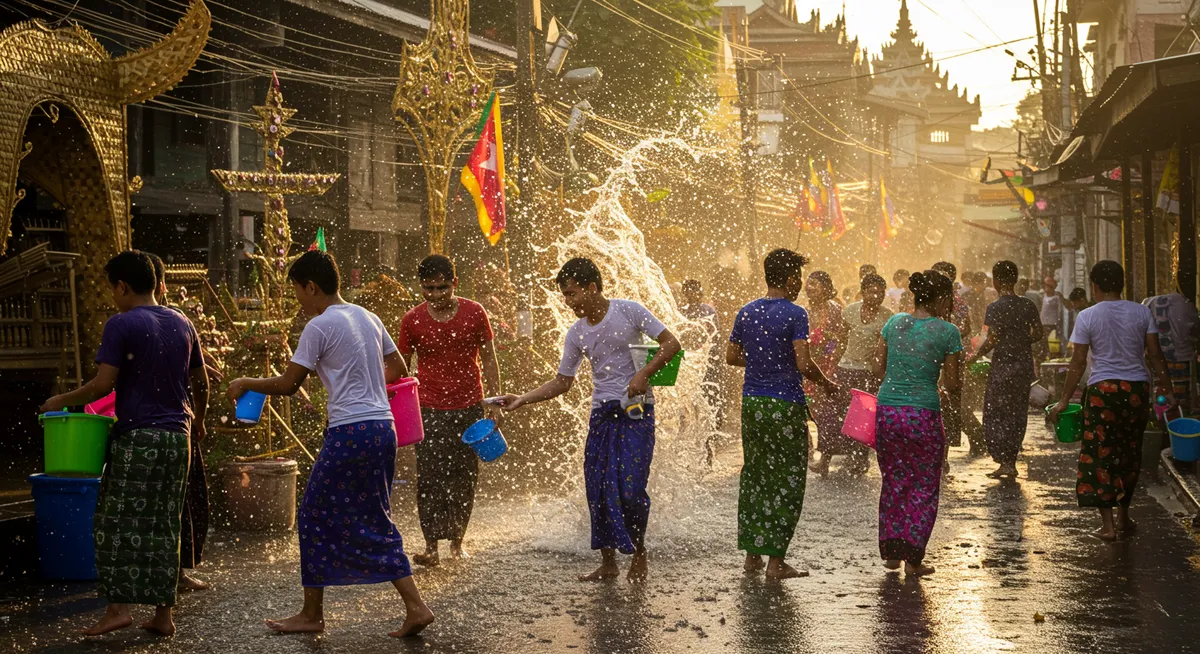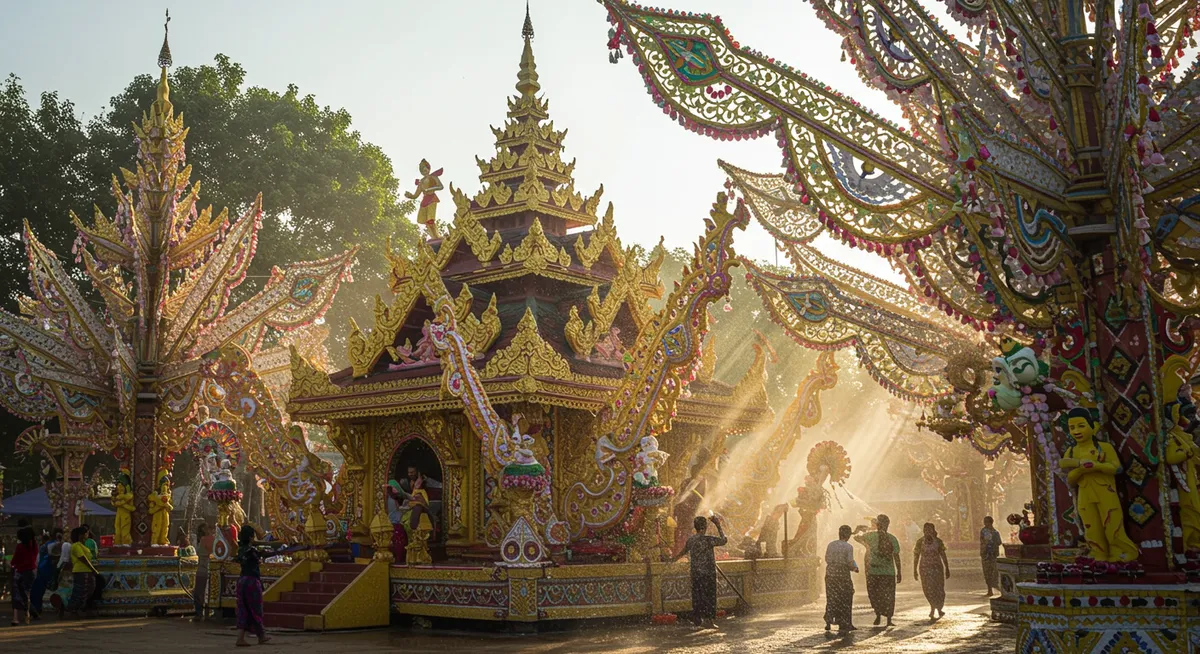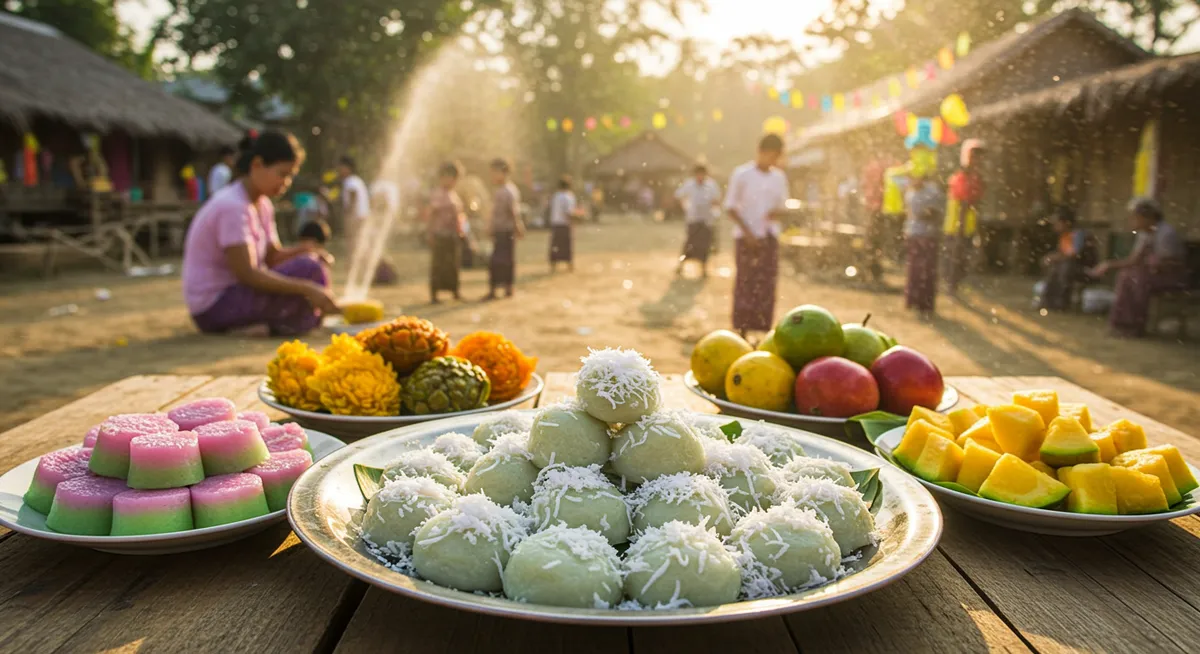Thingyan Water Festival Guide | Myanmar's New Year Celebration

Thingyan: Myanmar's Exuberant Water Festival and Buddhist New Year
Every April, Myanmar erupts in one of Southeast Asia's most exuberant celebrations as the entire nation engages in a joyful, multi-day water battle known as Thingyan. Often described as the world's largest water fight, this traditional Buddhist New Year celebration transforms Myanmar's cities and villages into festive, water-soaked playgrounds where social hierarchies temporarily dissolve and communal joy reigns supreme. Far more than just a playful water festival, Thingyan represents a profound cultural tradition marking cosmic transitions, spiritual purification, and community renewal. This guide explores the cultural significance, historical roots, and visitor experience of Myanmar's most beloved annual festival.

The Cultural Significance of Thingyan
Thingyan integrates spiritual traditions with communal celebration:
- Buddhist Purification: Water symbolizes the washing away of sins and misdeeds from the previous year
- Cosmic Transition: The festival marks the descent of the king of celestial beings (Thagyamin) to earth
- Agricultural Connection: Historically linked to the end of the hot, dry season before monsoon and planting
- Community Renewal: A time when social boundaries dissolve, promoting unity and shared experience
Historical Origins and Mythology
Thingyan's origins blend Hindu-Buddhist cosmology with local traditions:
- Brahmanical Roots: Derived from ancient Hindu traditions that spread through Southeast Asia
- The Thagyamin Myth: According to legend, the festival celebrates when the head of a defeated deity was placed in the sea, requiring annual ceremonies
- Seasonal Significance: Connected to agricultural cycles and the transition between dry and wet seasons
- Historical Evolution: From court rituals to inclusive public celebrations over centuries
Festival Structure and Timeline
Thingyan follows a traditional four-day structure, each with distinctive activities:
A-Kyo Nei (Eve of Thingyan)
The preparation day marks the transition to festival time:
- Cleaning Homes: Thorough cleaning to prepare for the new year
- Preparing Offerings: Creating flower arrangements and food offerings for temples
- Building Pandals: Construction of temporary water-throwing stations throughout cities
- Evening Ceremonies: Prayers and offerings anticipating the festival beginning
A-Kya Nei (First Day of Water Throwing)
The water celebrations officially begin:
- Morning Rituals: Formal ceremonies marking the descent of Thagyamin
- Initial Water Festivities: The first, often more restrained, water throwing
- Traditional Music: Thingyan songs played from stages and pavilions
- Temple Visits: Many people make offerings at Buddhist temples

A-Kyat Nei (Days of Full Celebration)
The main festival days feature peak water activities:
- Citywide Water Battles: Streets filled with people dousing each other with water
- Pandal Performances: Music and dance shows from decorated stages
- Water-Throwing Stations: Elaborately decorated platforms where revelers use hoses and buckets
- Processions and Parades: Traditional dance groups moving through streets
A-Tet Nei (Final Day)
The water festivities conclude with spiritual focus:
- Final Water Celebrations: Last opportunities for water throwing
- Buddha Bathing: Ceremonial washing of Buddha images with scented water
- Fish and Bird Release: Releasing captive creatures as acts of merit
- Temple Visits: Increased religious devotion as the festival ends
New Year's Day
Following Thingyan, the actual Myanmar New Year begins:
- Religious Observances: Dawn visits to temples with special offerings
- Elder Respect Ceremonies: Younger people pay respects to elders with symbolic washing
- Communal Feasts: Sharing of traditional foods with family and community
- Merit-Making Activities: Acts of charity and generosity to begin the year positively
Cultural Elements of Thingyan
Beyond water throwing, the festival incorporates rich cultural traditions:
Music and Dance
Distinctive artistic expressions mark the festival:
- Thingyan Songs: Traditional songs with specific rhythms and themes for the festival
- Yama Zatdaw: Performances depicting scenes from Buddhist literature
- Traditional Dance: Classical and folk dances performed on stages and in processions
- Modern Adaptations: Contemporary music intermixed with traditional performances
Festival Foods
Special seasonal dishes appear during Thingyan:
- Mont Lone Yay Paw: Glutinous rice balls with jaggery filling, boiled and served with grated coconut
- Thingyan Rice: Special rice dishes often shared with neighbors and friends
- Preserved Tea Leaf Salad (Lahpet Thoke): Featured prominently during festival gatherings
- Cooling Beverages: Traditional drinks made with palm sugar, tamarind, and other local ingredients

Buddhist Traditions
Religious practices form an essential counterpoint to the water festivities:
- Temple Offerings: Special flowers, food, and candles presented at pagodas
- Temporary Ordination: Some young men undertake brief periods as monks during this time
- Donation Ceremonies: Charitable giving to monasteries and the less fortunate
- Prayer Ceremonies: Extended prayer sessions at temples and monasteries
Regional Variations
While observed nationwide, Thingyan features distinctive regional expressions:
- Yangon: The nation's largest city hosts massive pandals and concerts along major avenues
- Mandalay: Traditional elements remain stronger in the cultural capital, with greater emphasis on classical performances
- Bagan: Celebrations amid ancient temples create a uniquely atmospheric experience
- Inle Lake: Water festivities incorporate the region's distinctive boat culture and floating villages
- Ethnic Variations: Different minority groups integrate their cultural traditions into the celebrations
Experiencing Thingyan as a Visitor
For travelers, Thingyan offers an extraordinary cultural immersion opportunity:
Practical Considerations
Participating in Thingyan requires some preparation:
- Complete Soaking: Understand that everyone in public spaces will get thoroughly wet
- Waterproof Essentials: Protect phones, cameras, and valuables in waterproof cases
- Appropriate Clothing: Wear modest but lightweight clothing that dries quickly
- Accommodation Planning: Book well in advance as this is peak travel season
- Transportation Awareness: Many streets close to traffic during the festival
Cultural Etiquette
Respectful participation enhances the experience:
- Temple Respect: Observe proper dress and behavior when visiting religious sites
- Gentle Splashing: Consider age and situation when splashing others
- Photography Courtesy: Ask permission before photographing individuals, especially in temples
- Alcohol Awareness: Traditionally, the festival doesn't involve heavy drinking
Best Locations for Visitors
Several areas offer particularly memorable Thingyan experiences:
- Kandawgyi Lake Area (Yangon): Major celebration hub with large pandals and performances
- Mandalay Palace Moat: Traditional celebrations in a historic setting
- Inle Lake: Unique water-based festivities in a stunning natural setting
- Smaller Towns: More intimate community celebrations with stronger traditional elements
Contemporary Thingyan
The festival continues to evolve in modern Myanmar:
- Environmental Considerations: Growing awareness of water conservation amid celebrations
- Modernization: Incorporation of sound systems, DJs, and contemporary music
- Tourism Impact: Increasing international interest and participation
- Cultural Preservation: Efforts to maintain traditional elements amid modernization
- Safety Improvements: Better organization and safety measures at major celebration points
Planning your Thingyan experience?
Thingyan typically falls in mid-April, coinciding with similar water festivals across Southeast Asia. The exact dates follow the traditional Burmese calendar and vary slightly each year.
For the best balance of festive activities and cultural experiences, plan to spend at least 3-4 days in Myanmar during the festival, allowing time for both water celebrations and the more reflective New Year traditions that follow.
Explore Related Asian Water Festivals
If you enjoy Thingyan, consider experiencing these related water festivals across Southeast Asia:
Songkran
Thailand's famous water festival celebrating Thai New Year with similar water purification traditions.
Pi Mai Lao
Laotian New Year with sacred Buddha bathing rituals and community water celebrations.
Chaul Chnam Thmey
Cambodian New Year with water blessings, temple visits, and traditional games.
Holi
India's festival of colors sharing similar themes of spring celebration and joyful revelry.
Sinulog
Philippines' vibrant celebration with street dancing and water traditions in some regions.
Vesak
Buddhist festival celebrating Buddha's birth, often including ritual water pouring.
The water festivals of Southeast Asia share ancient cultural connections, with Thailand's Songkran being the most internationally known. These celebrations reflect the regional importance of water as both a practical necessity and spiritual symbol of purification and renewal.